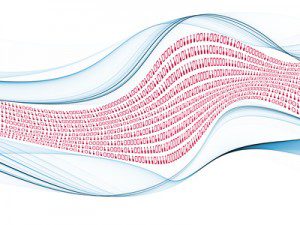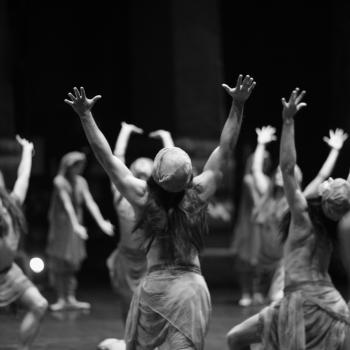Connor Wood
Ritual: it’s got a bit of bad rap. To many in the modern world, the very word “ritual” conjures images of rote and inscrutable actions, meaningless ceremonies, dusty and lifeless tradition. In fact, “lifeless,” “meaningless,” “dry” and “rote” probably cover about 80% of what most people think about ritual. And from my extensive research (that is, hanging out and talking with people), I’ve learned that a lot of today’s young adults grew up in traditions where the rituals did seem pretty dry and purposeless. But ritual has been around a lot longer than today’s religious institutions, and it doesn’t have to be pointless. One of my very favorite anthropologists, Roy Rappaport, articulated one good reason why: ritual boosts the signal-to-noise ratio in human societies.
Rappaport, who died in 1997 after a celebrated career at the University of Michigan, was a very, very smart guy. He pioneered the field of ecological anthropology, which is the study of how cultures manage their relationship to natural ecosystems and resources. In the course of his career, Rappaport came to believe that ritual played an important regulative function in cultures; without ritual, societies would simply get overwhelmed with useless, trivial social information, and would grind to a halt.
To explain why, let’s imagine your brain. A few pounds of grayish-white matter, it’s composed of something like 85 billion to 100 billion neurons. All of these neurons are capable of excitably talking to their neighbors, and their “conversations” convey information around the brain. As you may know if you’ve watched any television commercials for prescription antidepressants, neurons “talk” to other neurons by releasing neurotransmitters into the synapses between themselves and other cells. Their neighbors pick up those neurotransmitters through their own dendrites, and then either relay the message along to the next cell – or not.
The crucial part of this is the “action potential.” An action potential is a sudden shift in the electrical polarization of a neuron. When this shift happens – lasting just milliseconds – it sends the signal to release transmitters into the next synapse. Importantly, action potentials are “all or nothing” signals. Once electrical charge has built up to a certain threshold, the cell fires – but not before. And no matter how strong the signal coming into the cell, the cell fires only at a single, fixed intensity. It’s a bit like flicking a light switch – you can move the switch as slowly as you like, but the light itself is either off or on.
Once the neuron fires, “refractory period” follows (a phrase we all remember from middle school health class, for an entirely different reason) during which the neuron can’t be activated again. The refractory period keeps information from flowing backwards through cell networks, since the cell that just released the information can’t be bothered to light up again for several milliseconds. So the signal has nowhere to travel but forwards.
Why am I discussing neurons and action potentials when I was supposed to be talking about ritual? Simple: Roy Rappaport believed that ritual was something like the action potential of human cultures. Namely, ritual is a digital processing system that takes the messy, unclear data of social life, transforms it into binary signals, and sends those nice clear signals into the world.
A good example is puberty rites and initiation ceremonies. The transition from child to adult is long, complicated, and lacks a clear biological endpoint. When does a boy become a man – when he first grows facial hair, when his voice changes, or what? There’s no single answer, because the biological data is analog; that is, continuous. It has no absolutely clear transition points. (I didn’t feel like a grownup until well after my 10th high school reunion, for example.)
But in initiation rites, cultures take a continuous, analog physiological process and ritually transform it into a digital – that is, binary – shift in social roles. One day, you’re a boy. The next day, you go out to the bush, suffer through an initiation rite, and BAM – you’re a man.* Painful and sudden, maybe, but simple. So what’s the result? The amount of noise in the signal of social life is reduced. Of course biologically nothing has changed, but socially your expectations about your role and how you’re supposed to behave are irrevocably shifted. Out of a whole ton of vague, ambiguous biological information, an initiation rite distills a single, crisp social signal. Without a ritual acknowledgment of your transition, you might never be quite sure whether you’re a boy, whether you’re a man, whether you’re somewhere in between, or what you’re supposed to act like. The quality of your understanding about your environment – the information you have – will be lower.
In fact, almost any shift in social roles is ritualized in traditional and religious cultures, precisely because ritual reduces the noise-to-signal ratio. Think about how a relationship blossoms: a young couple meet, flirt, go on dates, have their first kiss. Eventually they’re spending most of their time with each other, and one day, one proposes to the other. At the marriage ceremony, standing in front of their peers, family, and friends, the couple goes through one formally socially recognized transformation. Although the process of building the relationship has been messy and filled with ambiguity, the wedding collapses all those ambiguities into a single, clear, binary transition.
The fact is that our world is filled with unspoken social conventions that transform messy, continuous information into clearer, binary data. Rappaport cited the American presidential election: the popular vote itself is continuous, or analog. It’s filled with noise. There are millions of votes cast for (usually two) candidates. No one candidate gets all the votes. But at the moment of the swearing-in, the winner of the election gets all of the presidency. A tremendous amount of information is erased in this ceremony: which states went Democrat and which Republican, who won the college-age vote, how slim or wide the popular vote margin was. All of that data is condensed and streamlined into one discrete piece of information: one candidate becomes president. The other doesn’t.
Because of the way that ritual simplifies and streamlines social information, Rappaport called it “the cybernetics of the holy.” Cybernetic systems are self-regulating, using feedback loops and critical thresholds to keep changes in one part of the system from overwhelming the other parts. Since rituals are ways of simplifying social relationships and roles, they prevent information from washing through societies to the point of paralyzing everything. Think about it: if the entire community had to react each time you developed a crush on someone, life would grind to a halt. This is why ritual exists: it establishes critical thresholds for taking on obligations, shifting our relationships to one another, or recognizing new states of affairs.
This means, for example, that momentary changes in how we feel about our spouses don’t gather enough momentum to “trickle up” to affect the entire community. By imposing thresholds on how and when communities formally recognize shifts in relationships, ritual stabilizes the information flow through cultures. The result is that most of the unimportant “noise” in the system gets cancelled out before it can overload the circuits of culture.
In our brains, neuronal action potentials are “all-or-nothing,” and tension has to build up to a critical threshold before any given neuron fires. This prevents trivial or unimportant impulses from fanning out throughout the brain and overwhelming it. Societies, in a very real way, function similarly. Brains and societies are both information processing systems. If noisy analog signal is allowed to propagate willy-nilly through such systems, there will be no useful information in the chaos. By placing strict thresholds at nodes throughout the network that take in analog signals and condense them to clear, digital packets of information, both brains and cultures make their operations a heck of a lot more efficient. So next time you see a baptism, a wedding, or a bar mitzvah and you think, “Meh, that’s just empty ritual,” remember that what you’re actually witnessing is people distilling the wild noise of life into a clear, cultural signal.
______
* Of course it is not actually this simple. This example was a dramatization. Do not try at home.












